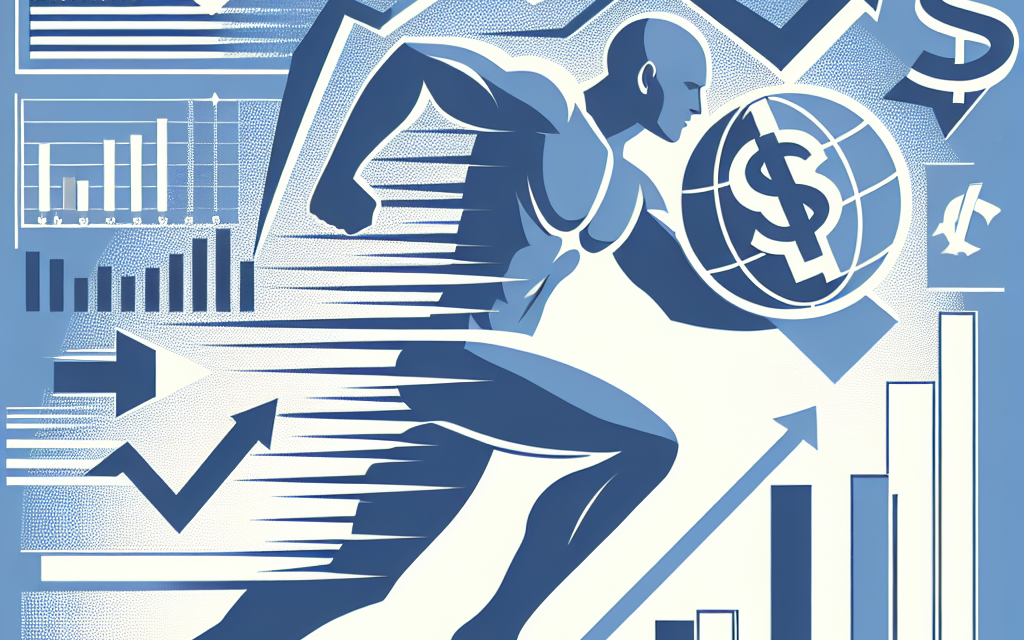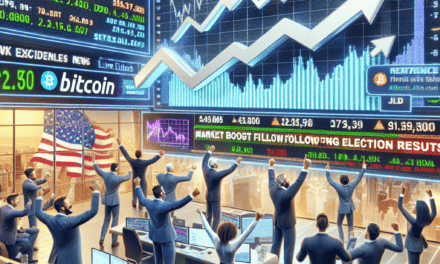“US Inflation: A Bump in the Road on the Global Economic Journey”
Introduction
In recent years, the global economic landscape has been marked by a series of dynamic shifts and challenges, with inflation emerging as a central concern for policymakers and economists worldwide. The United States, a key player in the global economy, has been grappling with inflationary pressures that have tested the resilience of its economic recovery. Despite initial progress in curbing inflation, recent developments indicate a setback, as inflationary trends have once again gained momentum. This resurgence poses significant implications not only for the U.S. economy but also for global markets, as interconnected economies navigate the complexities of supply chain disruptions, fluctuating commodity prices, and shifting consumer demand. Understanding the nuances of these inflationary trends is crucial for stakeholders aiming to anticipate and mitigate the potential impacts on economic stability and growth.
Impact Of Rising US Inflation On Global Markets
The global economic landscape is intricately interconnected, with developments in one major economy often rippling across the world. In recent months, the United States has been grappling with rising inflation, a phenomenon that has not only captured the attention of policymakers and economists domestically but has also sent shockwaves through global markets. As the world’s largest economy, the United States plays a pivotal role in shaping global economic trends, and any fluctuations in its economic indicators can have far-reaching implications.
To begin with, the resurgence of inflation in the United States has been driven by a confluence of factors, including supply chain disruptions, labor shortages, and increased consumer demand as the economy rebounds from the pandemic-induced slowdown. These inflationary pressures have led to a rise in the cost of goods and services, prompting the Federal Reserve to consider adjustments to its monetary policy. However, the progress in curbing inflation has hit a snag, as persistent supply chain issues and geopolitical tensions continue to exert upward pressure on prices.
The impact of rising US inflation on global markets is multifaceted. For one, it has led to increased volatility in financial markets worldwide. Investors, wary of the potential for tighter monetary policy in the United States, have been re-evaluating their portfolios, leading to fluctuations in stock and bond markets. Moreover, the prospect of higher interest rates in the US has strengthened the dollar, making it more expensive for other countries to service their dollar-denominated debts. This has been particularly challenging for emerging markets, which often rely on foreign capital to finance their growth.
Furthermore, the rise in US inflation has also affected global trade dynamics. As American consumers face higher prices, their purchasing power diminishes, potentially leading to a decrease in demand for imported goods. This scenario poses a risk to export-driven economies that rely heavily on the US market. Additionally, the increase in production costs due to inflation can lead to higher export prices, further complicating trade relationships.
In addition to these economic ramifications, the rise in US inflation has also influenced global monetary policy. Central banks around the world are closely monitoring the situation, as they weigh the need to balance domestic economic growth with the risks of imported inflation. Some countries have already begun to tighten their monetary policies in anticipation of potential spillover effects, while others remain cautious, opting to maintain accommodative stances to support their economic recoveries.
Moreover, the interplay between US inflation and global energy markets cannot be overlooked. Rising prices in the United States have contributed to increased demand for energy, driving up global oil and gas prices. This has had a cascading effect on energy-importing nations, exacerbating inflationary pressures and straining household budgets.
In conclusion, the rise in US inflation has undeniably impacted global markets, creating a complex web of challenges and opportunities. As policymakers and economists navigate this evolving landscape, the need for coordinated international efforts to address these issues becomes increasingly apparent. By fostering dialogue and collaboration, countries can work together to mitigate the adverse effects of inflation and ensure a more stable and resilient global economy. As the situation continues to unfold, it remains crucial for stakeholders to remain vigilant and adaptable, ready to respond to the ever-changing dynamics of the global economic environment.
Analyzing The Causes Behind The US Inflation Snag
The global economic landscape has been a subject of intense scrutiny, particularly as nations grapple with the aftermath of the COVID-19 pandemic and other geopolitical tensions. Among the myriad of economic challenges, inflation has emerged as a critical issue, with the United States experiencing a notable snag in its inflation progress. Understanding the causes behind this inflationary hiccup requires a multifaceted analysis, as several interrelated factors contribute to the current economic scenario.
To begin with, supply chain disruptions have played a significant role in exacerbating inflationary pressures. The pandemic-induced lockdowns and restrictions led to a severe bottleneck in global supply chains, affecting the availability of goods and raw materials. Although there have been efforts to restore normalcy, the lingering effects of these disruptions continue to impact production and distribution networks. Consequently, the scarcity of goods has driven prices upward, contributing to the inflationary trend observed in the US.
In addition to supply chain issues, labor market dynamics have also influenced inflation. The US labor market has experienced a paradoxical situation characterized by a high number of job openings alongside a substantial workforce shortage. This labor market tightness has resulted in increased wages as employers compete to attract and retain talent. While wage growth is generally positive for workers, it can lead to higher production costs for businesses, which are often passed on to consumers in the form of increased prices, thereby fueling inflation.
Moreover, energy prices have been a significant contributor to the inflation snag. The global energy market has witnessed considerable volatility, with oil and gas prices experiencing sharp fluctuations. Factors such as geopolitical tensions, production cuts by major oil-producing nations, and increased demand as economies recover have all contributed to rising energy costs. Since energy is a fundamental input for various industries, higher energy prices have a cascading effect on the overall cost of goods and services, further intensifying inflationary pressures.
Another critical factor to consider is the monetary policy stance of the Federal Reserve. In response to the economic downturn caused by the pandemic, the Federal Reserve implemented an accommodative monetary policy, characterized by low interest rates and substantial asset purchases. While these measures were instrumental in supporting economic recovery, they also contributed to increased money supply and liquidity in the economy. This excess liquidity, coupled with strong consumer demand, has played a role in driving up prices, thereby complicating efforts to rein in inflation.
Furthermore, fiscal policy measures have also had an impact on inflation dynamics. The US government implemented several fiscal stimulus packages to mitigate the economic fallout of the pandemic. While these measures provided much-needed relief to individuals and businesses, they also injected significant amounts of money into the economy. The resultant surge in consumer spending has added to demand-side pressures, contributing to the inflationary environment.
In conclusion, the snag in US inflation progress is a complex issue influenced by a confluence of factors, including supply chain disruptions, labor market dynamics, energy price volatility, and both monetary and fiscal policy measures. Addressing these challenges requires a coordinated approach that balances the need for economic recovery with the imperative to maintain price stability. As policymakers navigate this intricate landscape, understanding the underlying causes of inflation will be crucial in formulating effective strategies to mitigate its impact and ensure sustainable economic growth.
US Inflation Trends: Short-Term Setbacks Or Long-Term Concerns?
In recent months, the global economic landscape has been closely scrutinized, with particular attention paid to the inflationary trends in the United States. As the world’s largest economy, the U.S. plays a pivotal role in shaping global economic dynamics, and its inflationary patterns are often seen as a bellwether for broader economic health. However, recent data suggests that the progress made in curbing inflation may have encountered some obstacles, raising questions about whether these are merely short-term setbacks or indicative of more persistent, long-term concerns.
To understand the current situation, it is essential to consider the factors that have contributed to the recent inflationary pressures. Initially, the COVID-19 pandemic disrupted global supply chains, leading to shortages and increased costs for goods and services. As economies began to recover, demand surged, further exacerbating price pressures. In response, the U.S. Federal Reserve implemented a series of interest rate hikes aimed at tempering inflation. These measures appeared to be effective initially, as inflation rates began to show signs of moderation.
However, the recent resurgence in inflationary pressures suggests that the path to stabilization may not be as straightforward as previously anticipated. One contributing factor is the ongoing geopolitical tensions, particularly in Eastern Europe, which have led to volatility in energy markets. The resultant fluctuations in oil and gas prices have had a cascading effect on transportation and production costs, thereby influencing consumer prices. Additionally, labor market dynamics have also played a role, with wage growth outpacing productivity gains in certain sectors, further fueling inflation.
Moreover, the global economic environment remains fraught with uncertainties. The potential for new COVID-19 variants, coupled with varying vaccination rates across countries, poses a risk to the stability of international trade and travel. These uncertainties can lead to erratic consumer behavior, as individuals and businesses attempt to hedge against potential disruptions, thereby influencing demand and price levels.
In light of these complexities, policymakers face the challenging task of balancing inflation control with economic growth. While the Federal Reserve’s monetary policy tools are crucial in managing inflation, they must be wielded with precision to avoid stifling economic recovery. The risk of over-tightening could lead to a slowdown in economic activity, potentially triggering a recession. Conversely, underestimating inflationary pressures could erode purchasing power and destabilize financial markets.
As we assess the implications of these developments, it is important to consider the broader context of global economic trends. Inflation is not an isolated phenomenon but rather a reflection of interconnected factors that transcend national borders. Therefore, international cooperation and coordination are essential in addressing the root causes of inflation and ensuring sustainable economic growth.
In conclusion, while the recent setbacks in U.S. inflation progress are concerning, they do not necessarily signal an insurmountable challenge. By adopting a nuanced approach that considers both domestic and international factors, policymakers can navigate these complexities and work towards a more stable economic future. As the situation continues to evolve, ongoing analysis and adaptation will be key in determining whether these inflationary trends represent short-term fluctuations or more enduring challenges.
How US Inflation Affects International Trade Relations

The intricate web of global economic trends is often influenced by the economic health of major players like the United States. Recently, the progress in curbing US inflation has encountered unexpected challenges, which in turn has significant implications for international trade relations. As the US grapples with inflationary pressures, the ripple effects are felt across the globe, affecting trade dynamics, currency valuations, and economic policies in other nations.
To begin with, inflation in the US can alter the competitive landscape of international trade. When inflation rises, the purchasing power of the US dollar diminishes, leading to increased costs for imported goods. This scenario can result in a shift in consumer preferences towards domestically produced goods, thereby impacting countries that rely heavily on exporting to the US market. Consequently, these countries may experience a decline in their export revenues, which can strain their economies and lead to trade imbalances.
Moreover, the US dollar’s role as the world’s primary reserve currency means that fluctuations in its value have far-reaching consequences. Inflation can lead to a depreciation of the dollar, affecting exchange rates globally. For countries with currencies pegged to the dollar, this can necessitate adjustments in their monetary policies to maintain stability. Additionally, nations with significant dollar-denominated debt may face increased repayment costs, further complicating their economic outlook.
In response to US inflation, central banks around the world may be compelled to adjust their interest rates. For instance, if the Federal Reserve raises interest rates to combat inflation, other countries might follow suit to prevent capital outflows and maintain the attractiveness of their financial markets. This synchronized tightening of monetary policy can slow down global economic growth, as higher borrowing costs dampen investment and consumer spending.
Furthermore, US inflation can influence trade negotiations and agreements. Countries may seek to renegotiate terms to account for changes in cost structures and market conditions. For example, if inflation leads to higher production costs in the US, trading partners might push for more favorable terms to offset these increases. This can lead to prolonged negotiations and potential trade disputes, affecting the flow of goods and services across borders.
In addition to these economic considerations, US inflation can also have geopolitical implications. As countries adjust their trade strategies in response to inflationary pressures, alliances and partnerships may shift. Nations might seek to diversify their trade relationships to reduce dependency on the US market, fostering new regional trade agreements and collaborations. This realignment can alter the balance of power in international trade, with emerging economies potentially gaining more influence.
In conclusion, the progress of US inflation is not just a domestic concern but a global one, with significant implications for international trade relations. As inflationary pressures persist, countries around the world must navigate a complex landscape of economic adjustments, policy responses, and strategic realignments. The interconnectedness of the global economy means that developments in one nation can have cascading effects, underscoring the importance of coordinated efforts to address inflation and maintain stability in international trade. As such, policymakers and businesses alike must remain vigilant and adaptable in the face of these evolving economic challenges.
Strategies For Investors Amidst US Inflation Challenges
In recent months, the global economic landscape has been characterized by a series of complex challenges, with US inflation emerging as a particularly pressing concern. As inflation rates in the United States have shown signs of stalling, investors are left grappling with the implications for their portfolios. Understanding the nuances of this economic environment is crucial for developing effective investment strategies. To navigate these turbulent waters, investors must first comprehend the underlying factors contributing to the current inflationary pressures.
The US economy, like many others, has been significantly impacted by the aftermath of the COVID-19 pandemic. Supply chain disruptions, labor shortages, and increased consumer demand have collectively fueled inflationary trends. Initially, there was optimism that inflation would be transitory, driven by temporary factors. However, as inflation rates have persisted, it has become evident that more structural elements are at play. This realization has prompted investors to reassess their strategies, seeking ways to mitigate risks while capitalizing on potential opportunities.
One approach that investors might consider is diversifying their portfolios to include assets that traditionally perform well during inflationary periods. Commodities, for instance, have historically served as a hedge against inflation. As the prices of goods and services rise, so too do the prices of raw materials, making commodities an attractive option for those looking to preserve purchasing power. Additionally, real estate investments can offer a buffer against inflation, as property values and rental incomes tend to increase in tandem with inflationary pressures.
Moreover, investors should pay close attention to interest rate trends, as central banks, including the Federal Reserve, may adjust monetary policies in response to inflation. Rising interest rates can have a profound impact on various asset classes, particularly bonds. As interest rates increase, bond prices typically decline, which can erode the value of fixed-income investments. Consequently, investors may need to explore alternative fixed-income strategies, such as investing in shorter-duration bonds or inflation-protected securities, to safeguard their portfolios.
In addition to these traditional strategies, investors might also consider exploring opportunities in sectors that are poised to benefit from inflationary conditions. For example, companies in the energy sector often experience increased revenues during periods of rising prices, as the cost of oil and gas tends to climb. Similarly, consumer staples companies, which produce essential goods, may maintain steady demand even as prices rise, providing a degree of stability in uncertain times.
Furthermore, it is essential for investors to remain vigilant and adaptable, as the economic landscape continues to evolve. Regularly reviewing and adjusting investment strategies in response to new data and trends can help mitigate risks and enhance returns. Staying informed about global economic developments, as well as monitoring policy changes and market indicators, will be crucial for making informed investment decisions.
In conclusion, while US inflation presents significant challenges for investors, it also offers opportunities for those who are prepared to adapt their strategies. By diversifying portfolios, considering sector-specific investments, and staying attuned to interest rate trends, investors can navigate the complexities of the current economic environment. As the global economy continues to face uncertainties, a proactive and informed approach will be key to successfully managing investments amidst inflationary pressures.
Comparing US Inflation Trends With Other Major Economies
In recent years, the global economic landscape has been marked by a series of unprecedented challenges, with inflation emerging as a central concern for policymakers and economists alike. The United States, in particular, has experienced significant fluctuations in inflation rates, which have drawn comparisons with other major economies around the world. As we delve into the intricacies of these trends, it becomes evident that while the US has made some progress in curbing inflation, recent developments suggest that this progress may have hit a snag.
To begin with, it is essential to understand the broader context of inflation trends across major economies. In the aftermath of the COVID-19 pandemic, countries worldwide faced supply chain disruptions, labor shortages, and increased demand for goods and services, all of which contributed to rising inflation rates. The United States, with its robust consumer-driven economy, was no exception. Initially, the Federal Reserve’s monetary policies, including interest rate hikes and quantitative tightening, appeared to be effective in tempering inflationary pressures. However, recent data indicates that inflation in the US remains stubbornly high, raising concerns about the sustainability of these measures.
In contrast, other major economies have experienced varying degrees of success in managing inflation. For instance, the Eurozone has faced its own set of challenges, with energy prices and geopolitical tensions playing a significant role in driving inflation. The European Central Bank has adopted a cautious approach, balancing the need to support economic recovery with the imperative to control inflation. Meanwhile, Japan, which has long grappled with deflationary pressures, has seen a moderate rise in inflation, largely attributed to external factors such as rising import costs. This divergence in inflationary trends highlights the complex interplay of domestic and international factors influencing each economy.
Moreover, the comparison between the US and other major economies reveals differing policy responses and their implications. The US Federal Reserve’s aggressive stance on interest rates contrasts with the more measured approaches of the European Central Bank and the Bank of Japan. While higher interest rates in the US have helped to cool down certain sectors, such as housing, they have also raised concerns about potential negative impacts on economic growth and employment. In Europe, the focus has been on maintaining a delicate balance between inflation control and economic stability, with policymakers wary of triggering a recession. Japan, on the other hand, continues to prioritize economic growth, even as it navigates the challenges of rising prices.
As we consider the future trajectory of inflation in the US and other major economies, it is clear that uncertainty remains a defining feature of the global economic landscape. The interplay of factors such as geopolitical tensions, energy prices, and supply chain disruptions will continue to shape inflationary trends. For the US, the recent snag in inflation progress underscores the need for a nuanced approach that takes into account both domestic and international dynamics. Policymakers must remain vigilant, ready to adapt their strategies in response to evolving economic conditions.
In conclusion, while the US has made strides in addressing inflation, recent developments suggest that the path forward may be fraught with challenges. By comparing these trends with those of other major economies, we gain valuable insights into the complexities of managing inflation in a globalized world. As nations navigate this intricate landscape, the lessons learned from each other’s experiences will be crucial in shaping effective and sustainable economic policies.
Policy Responses To US Inflation: Lessons From The Past
In recent years, the global economic landscape has been significantly shaped by the persistent challenge of inflation, particularly in the United States. As policymakers grapple with the complexities of curbing inflation, it is essential to draw lessons from historical precedents to inform current strategies. The United States, a major player in the global economy, has experienced fluctuations in inflation rates that have prompted varied policy responses over the decades. Understanding these responses provides valuable insights into the effectiveness of different approaches and the potential pitfalls that may arise.
Historically, the United States has employed a combination of monetary and fiscal policies to address inflationary pressures. During the 1970s, for instance, the country faced stagflation—a period characterized by high inflation and stagnant economic growth. In response, the Federal Reserve, under the leadership of Paul Volcker, implemented aggressive interest rate hikes in the early 1980s. This monetary tightening successfully curbed inflation but also led to a severe recession. The lesson here underscores the delicate balance policymakers must maintain between controlling inflation and sustaining economic growth.
Fast forward to the present, the Federal Reserve has once again found itself at the forefront of combating inflation. In recent years, inflationary pressures have been exacerbated by supply chain disruptions, labor market imbalances, and unprecedented fiscal stimulus measures in response to the COVID-19 pandemic. Initially, the Fed adopted a more accommodative stance, maintaining low interest rates to support economic recovery. However, as inflation persisted beyond initial expectations, the central bank shifted towards a more hawkish approach, gradually increasing interest rates to temper demand and stabilize prices.
While monetary policy remains a critical tool in managing inflation, it is not without its limitations. The current economic environment presents unique challenges that differ from past inflationary episodes. For instance, global supply chain disruptions have played a significant role in driving up prices, a factor that traditional monetary policy tools are ill-equipped to address directly. Consequently, there is a growing recognition of the need for a coordinated policy response that extends beyond the central bank’s purview.
Fiscal policy, therefore, plays a complementary role in addressing inflation. By targeting specific sectors and addressing supply-side constraints, fiscal measures can alleviate some of the pressures contributing to rising prices. For example, investments in infrastructure and technology can enhance productivity and reduce bottlenecks, thereby easing inflationary pressures over the long term. Additionally, targeted fiscal support for vulnerable populations can help mitigate the adverse effects of inflation on household budgets, ensuring that economic recovery is inclusive and sustainable.
Moreover, international cooperation is increasingly vital in addressing the global dimensions of inflation. As economies are interconnected, inflationary pressures in one region can have ripple effects worldwide. Collaborative efforts to stabilize supply chains, enhance trade relations, and coordinate policy responses can contribute to a more stable global economic environment. Learning from past experiences, it is evident that a multifaceted approach, combining monetary, fiscal, and international strategies, is essential in effectively managing inflation.
In conclusion, the current challenges posed by inflation in the United States necessitate a nuanced and informed policy response. By drawing lessons from historical precedents and adapting them to contemporary circumstances, policymakers can navigate the complexities of inflation with greater efficacy. As the global economy continues to evolve, a proactive and coordinated approach will be crucial in ensuring sustained economic stability and growth.
Q&A
1. **What is the current state of US inflation?**
US inflation has recently encountered a setback, with rates not decreasing as steadily as anticipated.
2. **What factors are contributing to the inflation snag in the US?**
Contributing factors include supply chain disruptions, increased consumer demand, and rising energy prices.
3. **How is the Federal Reserve responding to the inflation issue?**
The Federal Reserve is considering adjusting interest rates and monetary policies to curb inflation.
4. **What impact does US inflation have on global markets?**
US inflation can lead to increased volatility in global markets, affecting exchange rates and international trade.
5. **How are consumers in the US affected by the inflation snag?**
Consumers face higher prices for goods and services, reducing purchasing power and impacting household budgets.
6. **What sectors are most impacted by the current inflation trends?**
Sectors such as energy, food, and housing are experiencing significant price increases due to inflation.
7. **What are the potential long-term effects if US inflation continues to rise?**
Prolonged inflation could lead to economic instability, reduced consumer confidence, and potential recessionary pressures.
Conclusion
The recent developments in global economic trends indicate that the progress made in curbing US inflation has encountered significant challenges. Despite earlier efforts to stabilize prices, various factors such as supply chain disruptions, geopolitical tensions, and fluctuating energy costs have contributed to renewed inflationary pressures. These obstacles highlight the complexity of achieving sustained economic stability and underscore the need for adaptive policy measures. As the US navigates these hurdles, the broader global economy remains sensitive to these dynamics, emphasizing the interconnected nature of modern economic systems. Continued vigilance and strategic interventions will be crucial in addressing these inflationary setbacks and fostering long-term economic resilience.





